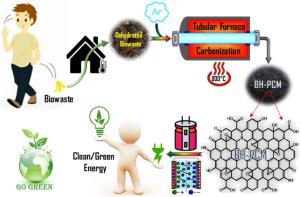Journal of Industrial and Engineering Chemistry ( IF 5.9 ) Pub Date : 2021-03-27 , DOI: 10.1016/j.jiec.2021.03.037 Atchudan Raji , Jebakumar Immanuel Edison Thomas Nesakumar , Shanmugam Mani , Suguna Perumal , Vinodh Rajangam , Somanathan Thirunavukkarasu , Yong Rok Lee

|
Here, a unique heteroatom-doped spongy carbonaceous material from dwarf banana peel has been synthesized successfully using the one-step hydrothermal method. The discarded banana peel was reused as a carbon source for the formation of heteroatom-doped porous carbon. This biowaste-derived heteroatom-doped porous carbonaceous material (BH-PCM) has plenty of interconnected pores with an acceptable surface area of 213 m2 g−1. Thoroughly characterized BH-PCM has been used as electrode material for supercapacitor using a three-electrode system with an aqueous 1 M H2SO4 solution. The as-synthesized BH-PCM holds an excellent specific capacitance of 137 F g−1 at 0.5 A g−1 and an impressive rate performance with a capacitance enduring 51 F g−1 at 5.0 A g−1. After 10,000 galvanostatic charge–discharge cycles, an initial capacitance of 94% was maintained. To show the practical applicability of the BH-PCM, the symmetrical two-electrode cell was fabricated and delivered the gravimetric specific capacitances of 87 F g−1 at 1 A g−1. The excellent electrochemical performance of BH-PCM towards supercapacitor was due to their high surface area, reasonable heteroatom doping rate, and a suitable degree of graphitization. This study offers a green approach for the development of environmental-friendly potential carbon-based electrode, by converting biowaste to clean/green energy.
中文翻译:

源自生物废物的杂原子掺杂多孔碳质材料,用于电化学储能
在这里,已经成功地使用一步水热法合成了来自矮人香蕉皮的独特的杂原子掺杂海绵状碳质材料。丢弃的香蕉皮被重新用作碳源,以形成杂原子掺杂的多孔碳。这种源自生物废物的杂原子掺杂的多孔碳质材料(BH-PCM)具有大量相互连通的孔,其可接受的表面积为213 m 2 g -1。彻底表征的BH-PCM已被用作超级电容器的电极材料,该电极使用三电极系统和1 M H 2 SO 4水溶液。合成后的BH-PCM在0.5时具有137 F g -1的出色比电容 a g -1和令人印象深刻的速率性能,在5.0 A g -1时的电容可承受51 F g -1的电容。经过10,000次恒电流充放电循环后,初始电容保持94%。为了显示BH-PCM的实际适用性,制造了对称的两电极电池,并在1 A g -1下提供了87 F g -1的重量比电容。 。BH-PCM对超级电容器的出色电化学性能归因于它们的高表面积,合理的杂原子掺杂速率和适当的石墨化程度。这项研究通过将生物废物转化为清洁/绿色能源,为开发环保的潜在碳基电极提供了一种绿色方法。











































 京公网安备 11010802027423号
京公网安备 11010802027423号